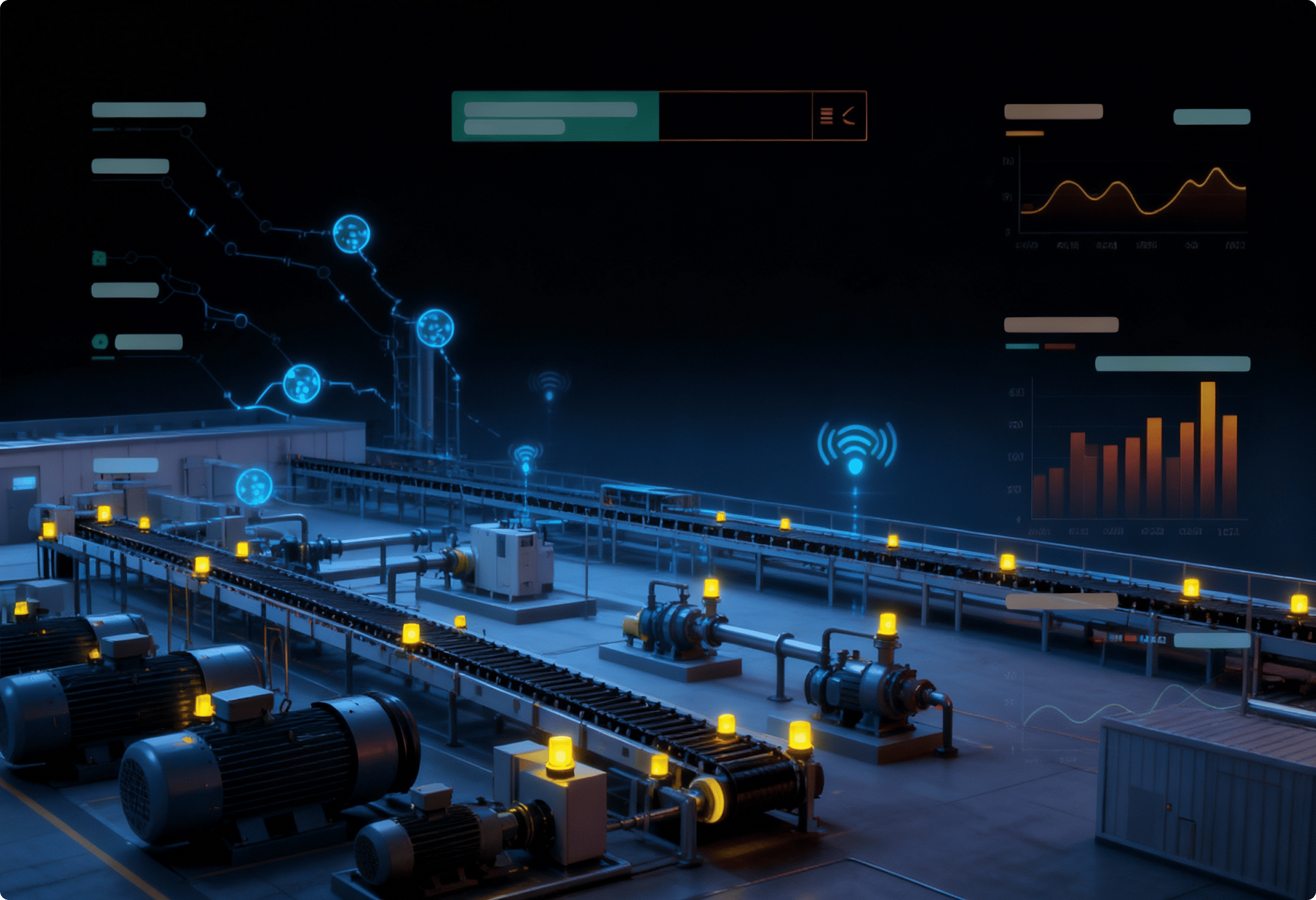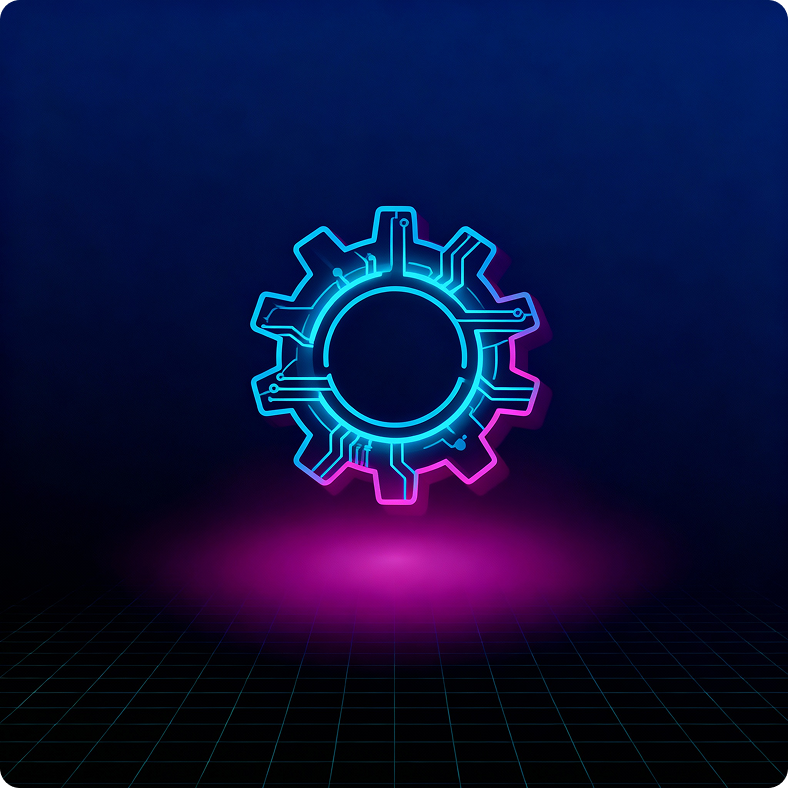Industrial IoT Sensors: Complete Guide to Smart Maintenance Infrastructure
How to select the right IoT sensors for equipment monitoring, design scalable IIoT architectures, and implement real-time data analysis that reduces maintenance costs by 30-45% and prevents 60-80% of unplanned failures.

TL;DR
Industrial IoT sensors transform reactive maintenance into predictive operations by capturing real-time equipment health data. Successful implementations achieve 30-45% maintenance cost reductions, 60-80% fewer unplanned failures, and 20-35% longer asset lifespans. However, 52% of IIoT sensor projects fail due to poor sensor selection, network architecture issues, or inability to process data at the edge effectively.
Highlights
- Start with vibration and temperature sensors on critical rotating equipment — these detect 70-85% of mechanical failures before they occur
- Choose wireless sensors with edge processing to reduce data transmission costs by 90-95% while maintaining sub-second response times
- Implement edge analytics that process data locally and send only alerts and anomalies to cloud systems, not raw sensor streams
Introduction
A bearing failure at ThyssenKrupp’s steel plant in Germany would typically cost €380,000 in emergency repairs and lost production. Their maintenance team installed wireless vibration sensors on 200 critical motors and pumps. Three months later, a sensor detected bearing wear developing in a conveyor motor. Maintenance replaced the bearing during a planned shutdown for €4,200. The sensor paid for itself in a single prevented failure.
Industrial IoT sensors provide continuous equipment monitoring that manual inspections and periodic checks can’t match. A technician walking a route once per shift spends maybe 30 seconds per asset. An IoT sensor monitors that same asset 86,400 times per day. According to Deloitte’s 2024 manufacturing survey, facilities deploying IIoT sensor networks report 30-45% lower maintenance costs and 60-80% fewer emergency breakdowns.
Yet implementation success rates disappoint. ARC Advisory Group found that 52% of industrial IoT projects launched in 2022-2023 either failed to deploy or didn’t deliver expected ROI. Common culprits: wrong sensor types for the application, network architectures that can’t scale, edge processing strategies that overwhelm bandwidth or miss critical events.
Sensor technology works. Wireless protocols are mature. Edge computing platforms are proven. The challenge lies in matching sensor capabilities to actual failure modes, designing networks that handle hundreds of devices reliably, and processing data close to assets rather than shipping everything to the cloud.
This guide covers sensor selection by failure type, IIoT architecture design, and edge analytics implementation based on deployments across automotive manufacturing, food processing, and heavy industrial operations.
Manual Monitoring Limitations
Walk-around inspections catch obvious problems — leaking seals, excessive noise, visible damage. They miss the early warning signs that matter most. A technician touching a bearing housing once per shift can’t detect the 2°C temperature increase over three days that signals lubrication breakdown. Handheld vibration tools provide snapshots but miss the gradual frequency shift indicating misalignment.
Periodic monitoring creates gaps. Equipment fails between inspection intervals. A pump inspected Monday morning fails Tuesday afternoon. The failure was developing for days, invisible until catastrophic.
Traditional Sensor System Problems
Wired sensor systems require extensive cabling — installation costs often exceed sensor costs. A European automotive plant quoted €8,500 per sensor point for wired vibration monitoring (€850 sensor, €7,650 installation). Retrofitting existing facilities becomes prohibitively expensive.
Centralized data processing overwhelms networks. Vibration sensors sampling at 25kHz generate 2.5GB per hour. Multiply by 200 sensors and you’re moving 500GB hourly to central servers. Network infrastructure can’t handle it. Cloud storage and processing costs become unsustainable.
Lack of standardization fragments systems. SCADA uses OPC-UA. Legacy PLCs speak Modbus. New sensors output MQTT. Integrating these requires custom middleware and ongoing maintenance as protocols evolve.
The Edge Processing Gap
Shipping raw sensor data to the cloud for analysis introduces latency — typically 2-15 seconds. For safety-critical applications or closed-loop control, this delay is unacceptable. A paper mill needs vibration anomaly detection in under 500 milliseconds to prevent web breaks.
Bandwidth limitations constrain deployments. Remote facilities — offshore platforms, mining operations, rural factories — have limited or expensive connectivity. Sending terabytes of sensor data isn’t feasible.
The future of manufacturing isn’t about collecting more data — it’s about collecting the right data at the edge and acting on it in real-time. Smart sensors are the foundation of intelligent operations.
— Dr. Sanjay Sarma, Former Vice President for Open Learning at MIT
Sensor Selection by Failure Mode
Vibration sensors detect 70-85% of mechanical failures — bearings, misalignment, imbalance, looseness. Use tri-axial MEMS accelerometers for general monitoring (€200-400 each) or piezoelectric sensors for precision applications (€800-1,500). Wireless options reduce installation costs by 85%.
Temperature sensors catch overheating, lubrication issues, electrical problems. Thermocouples work for high-temperature applications (€50-150). Infrared sensors enable non-contact monitoring of hard-to-reach equipment (€300-600).
Current sensors monitor motor health through electrical signatures. Detect rotor bar cracks, winding faults, load variations. Clamp-on sensors install without downtime (€180-350 per phase).
Pressure and flow sensors identify pump degradation, seal failures, blockages. Use for hydraulic and pneumatic systems (€250-800 depending on pressure range).
IIoT Architecture Design
Edge layer: Sensors with onboard processing. Calculate RMS vibration, temperature deltas, spectral analysis locally. Transmit only features and alerts — reduces data volume by 95%.
Gateway layer: Industrial gateways aggregate multiple sensors, perform protocol translation, provide local storage during connectivity loss. Support LoRaWAN, Zigbee, BLE, Wi-Fi sensors simultaneously.
Cloud/server layer: Long-term storage, ML model training, visualization dashboards. Receives processed data and alerts, not raw streams.
A food processing plant deployed 180 wireless sensors. Edge processing reduced cloud data from 4.3TB monthly to 86GB — saving €12,000 monthly in bandwidth and storage costs.
Watch: Explore how smart sensors and actuators form the backbone of modern Industrial IoT systems: Smart Sensors & Actuators in IIoT: Enabling Real-Time Intelligence.
Sensor Type Comparison
| Sensor Type | Detects | Cost Range | Installation |
| Vibration | Bearings, misalignment, imbalance | €200-1,500 | Magnetic mount, wireless |
| Temperature | Overheating, lubrication issues | €50-600 | Surface mount or infrared |
| Current | Motor faults, load issues | €180-350 | Clamp-on, no downtime |
| Acoustic | Leaks, cavitation, arcing | €400-900 | Directional mount |
Wireless Protocol Comparison
| Protocol | Range | Battery Life | Best For |
| LoRaWAN | 2-15 km | 5-10 years | Large facilities, outdoor |
| Zigbee | 10-100 m | 1-3 years | Dense sensor networks |
| BLE | 10-50 m | 6-18 months | Mobile monitoring |
| Wi-Fi | 50-100 m | Powered only | High-bandwidth needs |
For practical insights into wireless sensor deployment for environmental monitoring, this Сase study on indoor air quality sensors illustrates how facilities can use IoT infrastructure to track air conditions, improve safety, and reduce manual inspection overhead.
Real Implementation Case
Food Processing Conveyor Monitoring

Challenge: 85 conveyors across facility. Manual inspections missed bearing failures, causing production stoppages costing €45K each.
Approach: Deployed 170 wireless vibration/temperature sensors with edge analytics. LoRaWAN network covers 12 hectares. Gateway processes data locally, alerts on anomalies.


Results: Detected 23 bearing issues with 5-9 day warning. Zero unexpected failures in 14 months. Installation: €68K (€400/sensor including gateway). Savings: €580K annually from prevented downtime.
Key lesson: Edge processing was critical — raw data would have required €15K monthly cloud costs. Local analytics reduced to €800/month.

10-Week IIoT Deployment
Weeks 1-2: Asset Selection and Planning
Identify 20-30 critical assets based on downtime costs. Audit connectivity infrastructure and map sensor placement locations.
Weeks 3-4: Procurement and Network Design
Select sensors by failure mode. Order hardware. Design network topology — calculate gateway coverage zones and determine power requirements.
Weeks 5-6: Physical Installation
Mount sensors using magnetic bases or adhesive. Deploy gateways for optimal coverage. Configure wireless protocols and test signal strength.
Weeks 7-8: Edge Analytics Configuration
Program edge devices with processing rules. Set baseline thresholds. Configure local anomaly detection and data buffering.
Week 9: System Integration
Connect gateways to CMMS via APIs. Build dashboards. Configure automatic work order generation and mobile alerts.
Week 10: Validation and Training
Run parallel operations. Validate alerts and tune thresholds. Train maintenance team. Document baseline ROI metrics.
Critical factors: Start with 20-30 proven critical assets. Choose wireless to avoid installation costs — wired systems cost 4-6x more. Configure edge analytics from day one.
Pitfalls and Best Practices
Over-sampling: Logging vibration at 50kHz when 10kHz suffices wastes bandwidth and battery. Match sampling rate to failure frequencies you’re detecting.
Ignoring battery life: Wireless sensors transmitting every minute drain batteries in weeks. Configure hourly transmissions for non-critical assets, minute-level for critical only.
No edge processing: Sending raw data to cloud creates unsustainable costs. A pharmaceutical plant spent €45K monthly on cloud processing before implementing edge analytics, reducing to €3,200 monthly.
Poor gateway placement: Single gateway for 200 sensors 800 meters apart causes dropped packets. Deploy multiple gateways with overlapping coverage.
Best practices: Use mesh networking for reliability — sensors relay through neighbors if gateway unreachable. Implement local data buffering during connectivity loss. Version control edge processing rules as you tune thresholds.
Key Insights
- Sensor selection matters less than deployment strategy. Start with vibration and temperature sensors on 20-30 high-criticality assets rather than instrumenting everything. Facilities deploying sensors strategically see 3-4x better ROI than those attempting comprehensive coverage immediately.
- Edge processing reduces total cost of ownership by 80-90%. Processing data locally and transmitting only alerts and features cuts cloud costs from €8,000-15,000 monthly to €800-2,000 monthly for 200-sensor deployments while improving response time.
- Wireless protocols enable rapid scaling. LoRaWAN and Zigbee sensors install in minutes versus hours for wired alternatives, reducing deployment costs by 75-85% and making retrofits economically viable.
Related Resources
How to Choose a Web Development Company in the USA — and Why the Market Is Evolving Faster Than Ever
Explore a web partner who can handle IIoT stream ingestion, real‑time analytics, and production‑grade dashboards with secure API integrations.
Cloud-Based Maintenance Management: Benefits and Implementation
Learn how cloud platforms improve scalability, data security, and simplify migration from legacy on-premise systems.
Machine Learning for Equipment Failure Detection and Prevention
Compare ML algorithms and explore real-world deployments for accurate failure prediction in industrial environments.
Conclusion
Industrial IoT sensors deliver measurable results: 30-45% lower maintenance costs, 60-80% fewer unplanned failures, 20-35% longer asset life. The technology is mature and proven across industries.
Success requires three technical choices: matching sensor types to actual failure modes, designing networks with sufficient gateway coverage and redundancy, and processing data at the edge rather than centralizing everything in the cloud.
The IIoT landscape in 2026 favors practical deployments over comprehensive ambitions. Wireless sensor costs have dropped 60% since 2020. Battery life exceeds 5 years for many applications. Edge computing platforms are standardized and accessible.
Barriers to entry have collapsed. The question isn’t whether to deploy IoT sensors — it’s whether you’ll start with your most expensive failure modes before competitors do. Equipment downtime costs too much to rely on manual inspections and reactive maintenance.